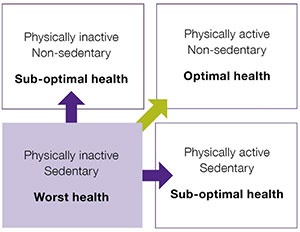Physical activity can happen at home, at school, at work, during leisure time and while getting from place to place. Being physically active is enjoyable, has huge health benefits and improves the quality of life for all individuals. It not only strengthens the body, but also makes people feel good about themselves, reduces stress, strengthens the heart and lungs, and helps prevents non-communicable chronic diseases.
It’s fun to be active with family and friends and there are many simple ways to do it every day. Enjoy a daily walk, take the stairs instead of the elevator, or spend less time in front of screens and more time in the great outdoors. You can also remember to park farther away in parking lots from buildings or get up from your desk and talk to a co-worker at the end of the hall instead of calling or texting them.
When talking about physical activity, we must also remember to talk about sedentary behavior. Sedentary behaviour is any behaviour when awake, that requires little to no energy and occurs while sitting or lying down. It can also occur at work or at school when sitting at a desk for a long periods of time or when home watching TV or playing video games.
Too much sedentary time can negatively affect someone’s health, regardless of how active they are. For example, an individual might be a regular runner, but also sit for long hours at a desk job each day. In this case, he or she would be considered physically active and sedentary.
The best-case scenario for optimal health is when an individual is physically active and non-sedentary. This individual is meeting physical activity guidelines, and has limited amounts of sedentary behaviour. The worst-case scenario is when individuals are both physically inactive and sedentary. We all need to think about how much we move, and how much we sit in order to reap the benefits.

What is Physical Literacy and why is it important?
In order to be physically active, you must be physically literate. Physical literacy is the motivation, confidence, physical competence, knowledge and understanding to value and take responsibility for being physically active. It is the foundation for an active lifestyle and is a life-long journey.
If we want young children to grow up to be active for life, we all have a part to play in developing their physical literacy skills. Parents, caregivers, and educators can provide children with the opportunities to explore their fundamental movement skills like running, jumping, and throwing through physical activity in a variety of settings including in water, on land, and in the air.
Having physical literacy skills results in more opportunities for people to be physically active. Like literacy and numeracy, building a foundation of movement skills early is easier and lasts into adulthood.
Learn more about physical literacy.
Additional Information
Below are links to additional information regarding physical activity to help you start thinking about moving more and sitting less to achieve a wide variety of health benefits.
- Canadian Physical Activity Guidelines
- ParticipACTION Partnership
- Provincial Initiatives
- Policy Documents
- Additional Resources
For more information about physical activity, please contact:
Ashley Button, B.Rec
Physical Activity Consultant
Healthy Living, Sport and Recreation Division
(709) 729-5281
ashleybutton@gov.nl.ca
